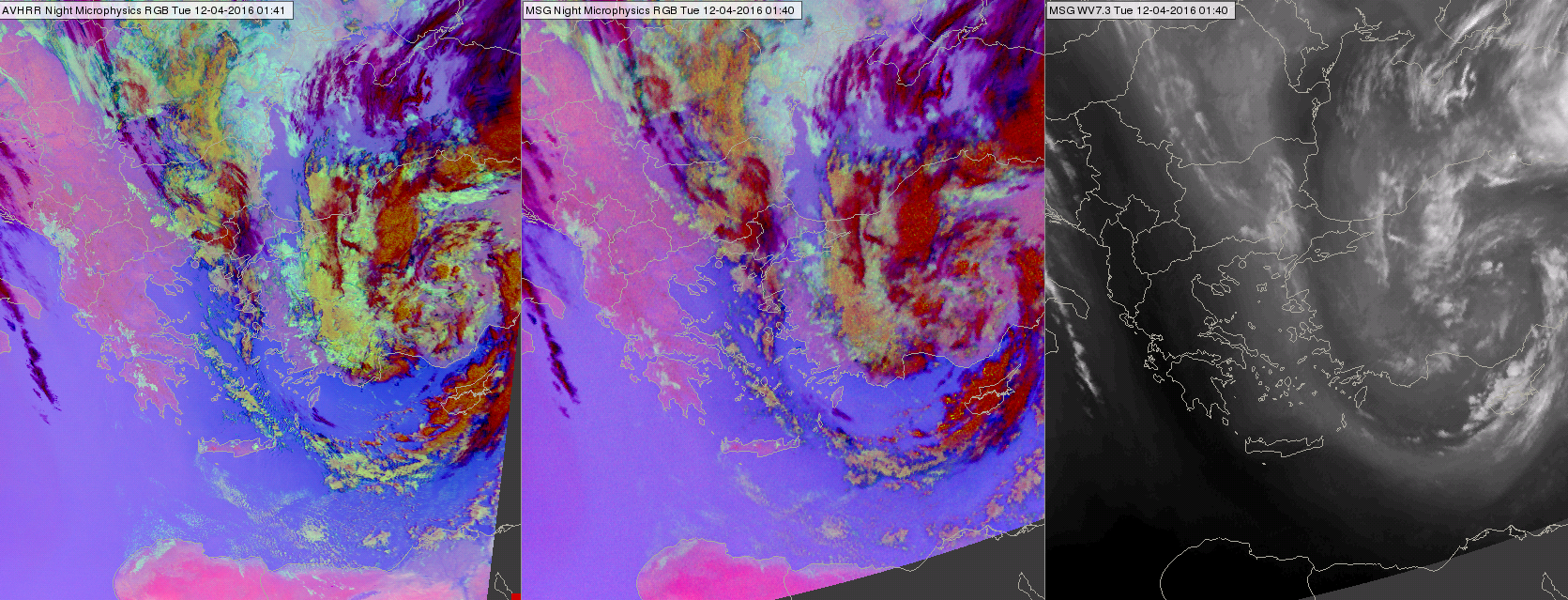Comparison of AVHRR and SEVIRI Night Microphysics RGB images
Table 2 shows the recipes of the AVHRR Night Microphysics RGB and EUMETSAT's recommended standard SEVIRI Night Microphysics RGB scheme. The recipes only differ in their green components. The central wavelengths of the AVHRR IR3.74 and SEVIRI IR3.9 channels are 'shifted'. The ranges of the green component are different due to differences in CO2 absorption in the IR3.74 and IR3.9 channels.
| AVHRR Night Microphysics RGB | ||||
|---|---|---|---|---|
| Color beam | Channel | Range | ||
| Red | IR12.0 - IR10.8 | -4 | +2 | K |
| Green | IR10.8 - IR3.74 | -4 | +6 | K |
| Blue | IR10.8 | 243 | 293 | K |
| SEVIRI Night Microphysics RGB | ||||
|---|---|---|---|---|
| Color beam | Channel | Range | ||
| Red | IR12.0 - IR10.8 | -4 | +2 | K |
| Green | IR10.8 - IR3.9 | 0 | +10 | K |
| Blue | IR10.8 | 243 | 293 | K |
Table 3: Recipes of the AVHRR and SEVIRI Night Microphysics RGB schemes, with the difference highlighted in yellow
Figs. 13 and 14 show both the AVHRR and the most closely coinciding SEVIRI Night Microphysics RGB images. The images have mostly similar colors, though the AVHRR has better color contrast between water clouds and the surface. Both RGBs reflect the effects of atmospheric moisture content. Fig. 13 displays it quite well; there is a potential mistral event where winds push dry air over the Mediterranean.
As already mentioned, noise in the IR3.74, IR3.9 brightness temperature fields can cause the appearance of green dots among the reddish brown colors of high, very cold clouds. This noise is stronger in the AVHRR Night Microphysics RGB than in the SEVIRI one, see for example Fig. 13.
Figure 13: AVHRR and SEVIRI Night Microphysics RGB images on 3 September 2014, 20:40 UTC
Fig. 14 shows a 3-panel image with an AVHRR Night Microphysics RGB, a MSG SEVIRI Night Microphysics RGB and a MSG SEVIRI WV7.3 image. The WV7.3 image shows the high moisture content region.
Figure 14: NOAA-19 AVHRR Night Microphysics RGB (left), MSG SEVIRI Night Microphysics RGB (middle) and MSG SEVIRI WV7.3 channel image (right) on 12 April 2016 at 01:41 and 01:40 UTC

